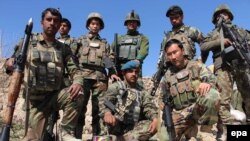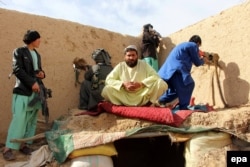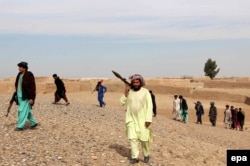LASHKAR GAH, Afghanistan -- A battle in a remote district in southern Afghanistan is likely to shape the future of the struggle for the country’s largest province.
The fighting in Sangin, a district in southern Helmand Province, is key to the success or failure of a Taliban push to run over the province, where the insurgents now control large swathes of territory.
Strategically located on Pakistan’s border and in close proximity to Iran, Helmand is the global epicenter of opium and heroin production. Its capture will not only fill Taliban coffers but will boost insurgent recruitment. Fighters from the region played a key role in enabling the Taliban to overrun most of Afghanistan in the 1990s.
Sangin is strategically located in northern Helmand and is vital to the region’s drug trade. Its fall to the insurgents will imperil the provincial capital, Lashkar Gah, some 90 kilometers away.
Provincial Governor Hayatullah Hayat says the insurgents have suffered significant losses in the ongoing fighting.
“The enemy has employed a new tactic this time around. They dug a tunnel from 3 kilometers away into some of our posts to then blow them up with tons of explosives,” he told Radio Free Afghanistan on February 2. “They destroyed six of our posts this way. We still don’t know our casualty figures, but in our counterattacks 32 enemy fighters were killed and more than 40 were injured.”
Hayat says Afghan government reinforcements, including special forces, are now in Sangin to back up the Afghan forces. “We now have sufficient forces, and we are surveilling the region from the air. If needed, we are ready to send even more forces in.”
The current fighting in Helmand flared up on January 30, when the Taliban overran many police checkpoints around the Sangin’s dusty bazaar, where a few government buildings and the military base are located.
Local tribal leader Haji Meera Jan says the Taliban attack began with a loud bang as they blew up a local clinic where some 40 Afghan soldiers were being treated.
“In the daylong fighting that followed, the government forces retreated to the main district building,” he said.
Afghan government forces snatched Sangin back from the Taliban after the insurgents briefly captured it last year. Mohammad Daud, another tribal leader, says their requests for reinforcements were not answered in time.
“We warned the government to send sufficient reinforcements in time or be ready to sustain heavy losses,” he said. “If the government cannot keep the district then it should pull out its forces there. It shouldn’t send soldiers to die in the name of honor.”
Ghulam Jan, a Sangin community leader, says the Afghan forces were initially outgunned by the Taliban.
“Despite fighting bravely, our forces have been overwhelmed by the government, which is just sleepwalking through this fiasco,” he said. ‘If nothing else, they could conduct some decisive air strikes.”
Majeed Akhunzada, a member of Helmand’s provincial council, says the fall of Sangin will pave the way for the insurgents to overrun neighboring Greshk district. Also called Nahr-e Siraj, its fall will complete the insurgents’ siege of neighboring Laskhar Gah.
“It will be a repeat of the debacle in Musa Qala, handing over the entire province to the armed opposition,” he said, referring to the fall of another north Helmand district last year. “That defeat also paved the way for the fall of [neighboring] Marjah and Nad-e Ali, which ultimately projected the enemy to overshadow southern Helmand [and] the provincial capital.”
When thousands of NATO troops left Helmand at the end of 2014, the Taliban only controlled two out of its 14 districts. The insurgents never gave up mountainous Baghran in the north and mostly controlled the southern desert district of Daishu.
Today, the Taliban control most northern Helmand districts such as Baghran, Nawzad, and Musa Qala. Government outposts in Washer and Kajaki are under constant insurgent attack. During the past two years, the insurgents also overran Nawa and Khanshin districts.
Kabul may have finally woken up to the challenge. Afghan Chief Executive Abdullah Abdullah toured Helmand this week. He was modest about the government’s efforts to reclaim Helmand but promised more protection for Lashkar Gah and its 2 million residents.
“You will soon see the results of our resolve,” Abdullah told provincial leaders.
Abubakar Siddique wrote this story based on Radio Free Afghanistan correspondent Mohammad Ilyas Dayee's reporting from Lashkar Gah, Helmand.










